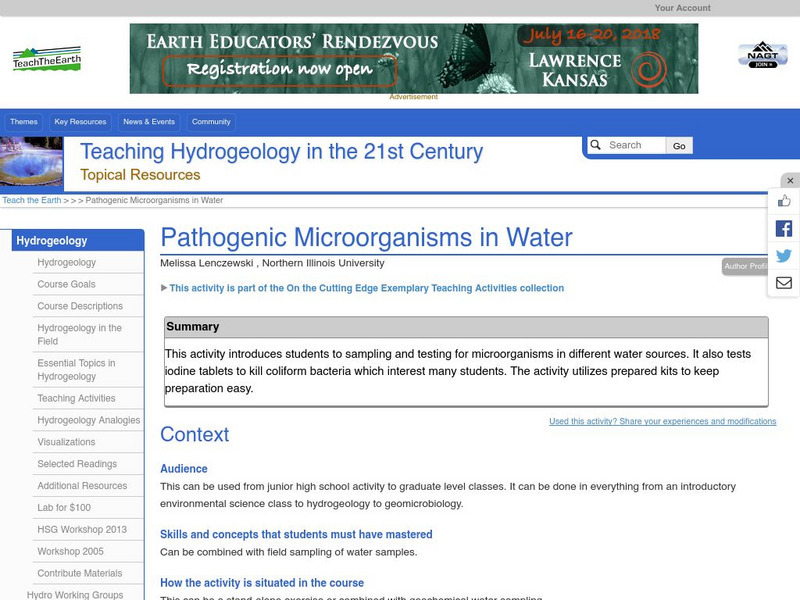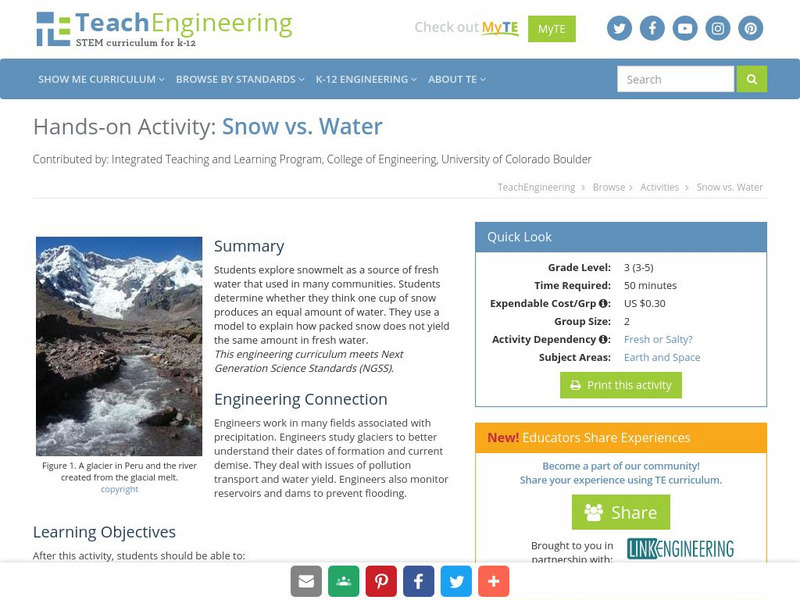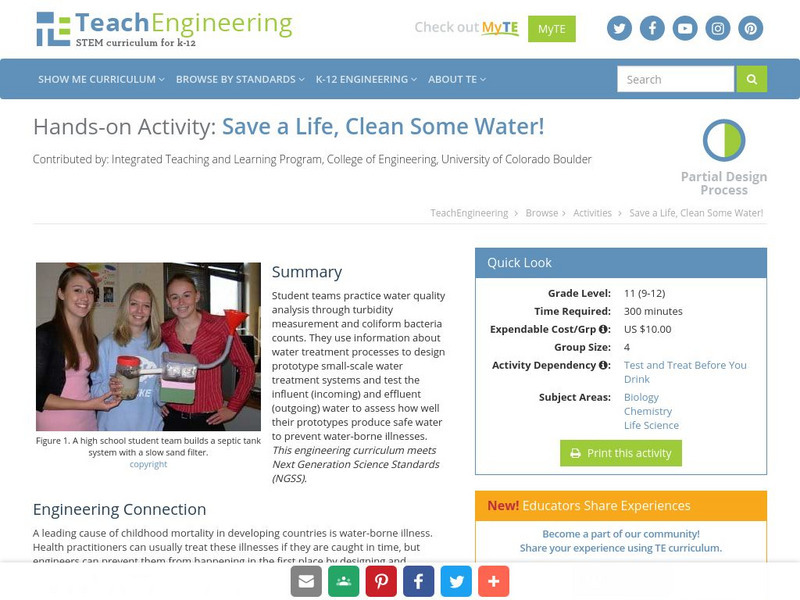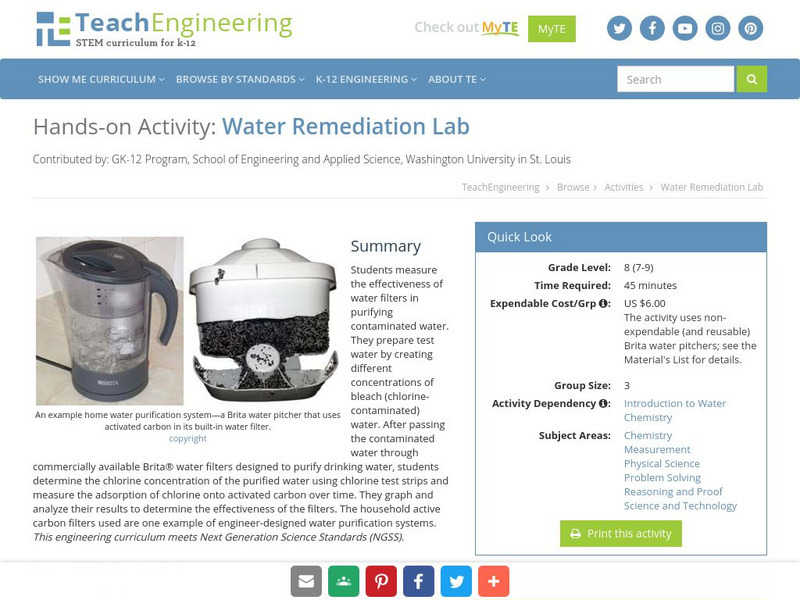eSchool Today
E School Today: Your Cool Basics on Water Shortage
Despite seventy percent of the world's surface being covered with water, there is a potential shortage of this natural resource. Only a small percentage is fresh water and much of that is inaccessible or threatened. Learn about fresh...
US Environmental Protection Agency
Epa: Water Topics
This website provides consumer information from the EPA about drinking water and water bodies.
Purdue University
Purdue Engineering/wellhead Protection
This resource describes what well head protection is, what you can do, case studies, why you should care, and related links.
Society for Science and the Public
Science News for Students: Water Sensor Quickly Detects Algal Poison
A new sensor can detect poisons from harmful algae within minutes so that drinking-water plants can start timely treatments.
Other
Extox Net Fa Qs: Water Treatment
Discusses many options of water treatment, the contaminants that the treatments are focused on, how the treatment works, and common treatment systems.
Other
Iepa:wellhead Protection in Community Water Supply Wells
Discusses what wellhead protection is, why it is needed, who is involved, a step by step plan, and a nice diagram of a well and the surrounding area.
Other
British Columbia Water and Waste Association
Non-profit organization that educates and trains people to safeguard public health and the environment. Water and wastewater industries are important parts of an environmental plan that ensures the future use of Canada's water supply.
US Geological Survey
Usgs: Water Science for Schools Water Science Storytime!
This U.S. Geological Survey website features a fictious town, Dryville, and uses it to illustrate every aspect of water management that you might encounter. Click Home to access the site in Spanish.
US Geological Survey
Usgs: Water Science for Schools Activities Center
This website offers three activity centers: Questionnaires, Opinion Surveys, and Challenge Questions. Take a look at these interesting water research activities from the US Geological Survey. Click Home to access the site in Spanish.
PBS
Pbs News Hour: Water Recycling
PBS and the Online NewsHour have created this multimedia website about water recycling. You can see how this process is different than other waste water treatments by reading interviews, watching a slideshow or investigating a map of...
Other
Nutrition Action: Water, Water, Everywhere
The Center for Science in the Public Interest offers a discussion of contaminants that can be found in tap water and chemicals added to water in the public water systems. The topics discussed are arsenic, parasites, lead, turbidity, and...
Other
Wet in the City: A Recipe for Clean Water [Pdf]
In this hands-on lesson, middle schoolers will examine the labels on common household products to determine what hazardess chemicals they contain, then test less toxic alternatives to see their affects on water quality. Students will...
Other
Nova Scotia Environment: Iron Bacteria and Sulphur Bacteria [Pdf]
Information page on iron bacteria and sulfur bacteria, both of which can affect the quality of drinking water from a well. Includes guidance on how to recognize their presence, what to do if there is a problem, and how to maintain water...
US Environmental Protection Agency
Epa: Water on Tap: What You Need to Know
Downloadable booklets with basic information about the U.S. water supply, e.g., where our drinking water comes from.
Science Education Resource Center at Carleton College
Serc: Pathogenic Microorganisms in Water
Use this lesson plan to introduce students to testing water sources for pathogenic microorganisms. Students will learn methods for groundwater sampling to evaluate water quality. Lesson plan includes student worksheets.
Georgia Department of Education
Ga Virtual Learning: Ap Environmental Science: Water Pollution and Treatment
Students learn about water management, treatment and purification- global issues that must be addressed to ensure a continued supply of safe water for the growing human population and for the organisms with which we share this planet.
DOGO Media
Dogo News: The Water Crisis in Flint, Michigan
Article explains the water crisis currently affecting the citizens of Flint, Michigan. Includes video.
TeachEngineering
Teach Engineering: Water Desalination Plant
Students use a thermal process approach to design, build and test a small-scale desalination plant that is capable of significantly removing the salt content from a saltwater solution. Students use a saltwater circuit to test the...
TeachEngineering
Teach Engineering: Snow vs. Water
Engineers work in many fields associated with precipitation. Engineers study glaciers to better understand their dates of formation and current demise. They deal with issues of pollution transport and water yield, and they monitor...
TeachEngineering
Teach Engineering: Pump It!
Pumps are used to get drinking water to our houses every day! And in disaster situations, pumps are essential to keep flood water out. In this hands-on activity, student groups design, build, test and improve devices to pump water as if...
TeachEngineering
Teach Engineering: Save a Life, Clean Some Water!
Student teams practice water quality analysis through turbidity measurement and coliform bacteria counts. They use information about water treatment processes to design prototype small-scale water treatment systems and test the influent...
TeachEngineering
Teach Engineering: Would You Drink That?
This activity focuses on getting students to think about bacteria, water quality and water treatment processes. Students develop and test their hypotheses about the "cleanliness" of three water samples prepared by the teacher. Then they...
TeachEngineering
Teach Engineering: Things That Matter to Flocculants
Prior to reaching households, water is exposed to a variety of treatments designed to render it fit for human consumption and use. One of the first treatment steps is the removal of suspended solids using chemical additives called...
TeachEngineering
Teach Engineering: Water Remediation Lab
Students measure the effectiveness of water filters in purifying contaminated water. They prepare test water by creating different concentrations of bleach (chlorine-contaminated) water. After passing the contaminated water through...











![Nova Scotia Environment: Iron Bacteria and Sulphur Bacteria [Pdf] Website Nova Scotia Environment: Iron Bacteria and Sulphur Bacteria [Pdf] Website](http://content.lessonplanet.com/resources/thumbnails/410103/large/bwluav9tywdpy2symdiwmduymc0xodkwni0xnjd4bw8uanbn.jpg?1589985415)










